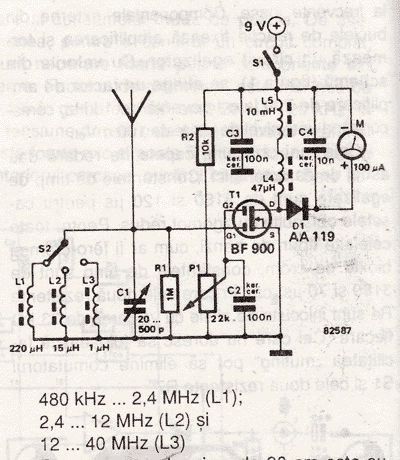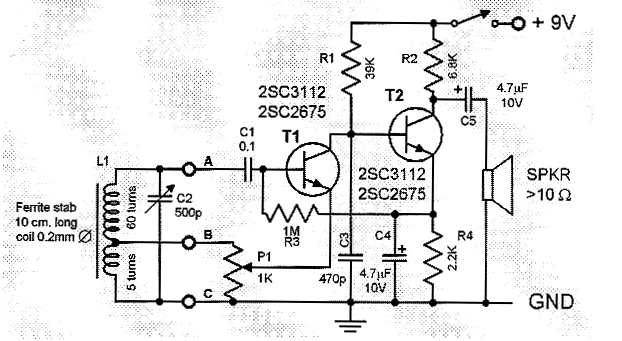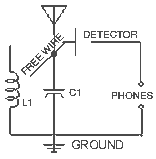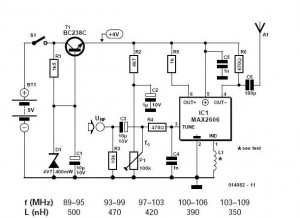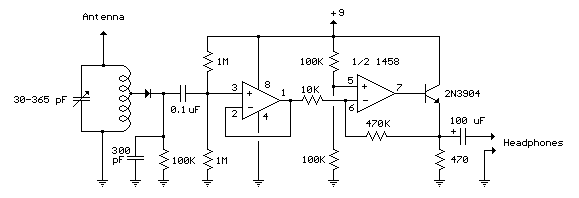
Amateur Radio circuits
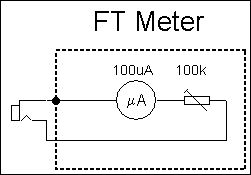
For the shorter wavelength VHF and UHF bands, it is more practical to construct complex antennas such as a single-band Slim Jim or Yagis. Various projects include creating an electronic unit, as it is necessary for the Intermediate Level license to build several practical electrical and electronic circuits and a complete, useful device related to amateur radio. One project chosen was a Morse Code Practice Oscillator, which is detailed further down this page. A Field Strength Meter (FSM) was also constructed and is showcased on this page. In January 2012, a microphone adapter cable was created to connect a dynamic stick microphone and a separate PTT hand or foot switch to the Kenwood TS-590S transceiver. This led to an exploration of transmitted audio quality and subsequent filtering and DSP adjustments, which proved to be very useful and interesting. Due to an inability to operate from March 2010, with all equipment packed away for a house move that was delayed and eventually fell through, new ideas for homebrew (DIY) projects were conceived. These ideas are documented on this page, including a home-brew FT Meter for the Yaesu FT-857D and a QRP Dummy Load with power measurement and ALC adjustment for QRP operation of the FT-857D. Prior to these projects, some microphone rewiring was completed, which can also be found here. Additionally, Baluns and Ununs were constructed, although not all projects were fully documented. Experimentation with different types of antennas has taken place, including a Compact Top Band Aerial. There is also an intention to use a separate microphone on a boom or gooseneck, leading to the development of ideas for a dynamic mic preamp and a separate break-out PTT switch. Components for these small electronic projects were ordered from Bowood Electronics and JAB Electronic Components. ESR supplied various uni-directional electret microphone elements that are difficult to find elsewhere. Time to start these projects is anticipated after the house move. The necessary electrical conduit and aluminum round bars or tubes for the antenna projects will likely be sourced from B&Q. A simple construction project that will effectively utilize a few hours is a communications speaker. The finished loudspeaker offers a clear sound and high efficiency, optimizing any transceiver's audio output power. The switchable filter adds an additional benefit. Many small communications extension speakers tend to produce harsh, resonant, and tinny sounds, which, while aiding speech intelligibility, can be inefficient, requiring significant audio power to drive. This can push the transceiver's audio amplifier towards its power limitations, resulting in harmonic distortion or clipping distortion. To address the issue of harsh audio reproduction, the use of a larger loudspeaker drive unit is recommended. To maximize the audio output of the transceiver's audio amplifier, a highly efficient loudspeaker driver unit is essential.
The construction of antennas for VHF and UHF bands often necessitates the use of more sophisticated designs, such as Slim Jim and Yagi antennas. These antennas are engineered to enhance signal reception and transmission capabilities in the specified frequency ranges. The Slim Jim antenna, characterized by its simple design and effective performance, is ideal for portable applications, while the Yagi antenna offers high gain and directivity, making it suitable for fixed installations.
For the Intermediate Level license, hands-on experience with electronic circuits is crucial. The Morse Code Practice Oscillator serves as an educational tool, allowing users to practice Morse code transmission and reception. This oscillator typically consists of a simple oscillator circuit, a keying mechanism, and an audio output to produce the characteristic tone of Morse code.
The Field Strength Meter (FSM) is another critical device for amateur radio operators, providing a means to measure the strength of radio signals. This device aids in the alignment and optimization of antennas, ensuring effective communication. The FSM circuit usually incorporates a sensitive RF detector and an analog or digital readout to display signal strength.
The microphone adapter cable project highlights the importance of audio quality in amateur radio communication. By connecting a dynamic microphone and a PTT switch to the Kenwood TS-590S transceiver, users can enhance their audio input, resulting in clearer transmissions. The exploration of audio quality may involve implementing filters and digital signal processing (DSP) techniques to refine the transmitted audio.
Homebrew projects such as the FT Meter and QRP Dummy Load illustrate the practical application of electronic components and circuit design. The FT Meter provides real-time monitoring of the transceiver's frequency output, while the QRP Dummy Load allows for safe testing of low-power transmitters without radiating signals.
The development of a dynamic microphone preamp and break-out PTT switch aims to improve the versatility of microphone setups in amateur radio. This preamp circuit typically includes gain control and impedance matching to ensure optimal performance with various microphone types.
The importance of speaker design in amateur radio cannot be understated. A well-designed communications speaker must balance efficiency and sound quality to prevent distortion and maintain clarity. The incorporation of a switchable filter allows users to tailor the audio response to their preferences, further enhancing the listening experience.
In conclusion, these projects and components reflect the ongoing innovation and experimentation within the amateur radio community, emphasizing the importance of practical skills and the pursuit of high-quality communication.For the shorter wavelength VHF and UHF bands it`s more practical to construct more complex antennas such as a single band Slim Jim or Yagis; I`ve had a go at a few such projects. Other projects will be an electronic unit of some kind: For the Intermediate Level licence it is necessary to make several practical electrical and electronic circuits and also build a complete and useful device related
to the subject of amateur radio. I chose to make a Morse Code Practice Oscillator; this project can be seen a little bit further down this page here. I have also built a Field Strength Meter - "FSM" also shown further down this page here. In January 2012 I set about making a microphone adapter cable to connect a dynamic `stick` microphone and a separate PTT hand or foot switch to the Kenwood TS-590s transceiver.
This, of course, led to looking at the transmitted audio quality and the subsequent filtering and DSP adjustments which has all been very useful and interesting. Read more here. Due to being unable operate from March 2010 with all my equipment being packed away for a house move that had been constantly delayed and finally fell through, I began thinking about a few more ideas for homebrew (d.
i. y. ) projects. I have also put those ideas on this page: I built a a home-brew `FT Meter` for the Yaesu FT-857D shown here and a QRP Dummy Load with power measurement and ALC adjustment for QRP operation of the FT-857D shown here. Previous to those projects I also did a little microphone re-wiring - to be seen here. I have also made some Baluns and Ununs and while I have not documented the whole projects I have noted down the ideas here.
The other thing I have been doing is trying different types of antenna, my Compact Top Band Aerial can be seen here. I would like to be able to use a separate microphone on a boom or gooseneck, so I am bringing together some ideas for a dynamic mic` preamp and separate `break-out` PTT switch here> The components required for the small electronic projects were ordered from Bowood Electronics and JAB Electronic Components.
ESR supplied a couple of different uni-directional electret microphone elements which are quite difficult to find elsewhere. I just need to find some time to start - sometime after we`ve moved house! The necessary electrical conduit and aluminium round bar or tubes for the antenna projects will probably be obtained from B&Q.
Here`s a nice simple little construction project that will make pleasant use of hour or two and produce a very useful communications speaker. My finished loudspeaker has a pleasant, clear sound and is very efficient, making the most of any transceiver`s audio output power.
The switchable filter is a nice bonus too. I have found that most of the small communications extension speakers that I have used have a harsh, resonant and `tinny` sound that does assist in making speech especially intelligible. Another problem is that many speakers are also quite inefficient - that is to say that they need a good degree of audio power to drive which can mean that the audio amplifier in the transceiver may be run towards its power limitations resulting in undesirable harmonic distortion or even worse, clipping distortion.
To overcome the harsh, tinny audio reproduction requires the use of a larger loudspeaker drive unit. To maximise the available audio output of the transceiver`s audio amplifier requires the use of a highly efficient loudspeaker driver unit. Yaesu very thoughtfully a 🔗 External reference
The construction of antennas for VHF and UHF bands often necessitates the use of more sophisticated designs, such as Slim Jim and Yagi antennas. These antennas are engineered to enhance signal reception and transmission capabilities in the specified frequency ranges. The Slim Jim antenna, characterized by its simple design and effective performance, is ideal for portable applications, while the Yagi antenna offers high gain and directivity, making it suitable for fixed installations.
For the Intermediate Level license, hands-on experience with electronic circuits is crucial. The Morse Code Practice Oscillator serves as an educational tool, allowing users to practice Morse code transmission and reception. This oscillator typically consists of a simple oscillator circuit, a keying mechanism, and an audio output to produce the characteristic tone of Morse code.
The Field Strength Meter (FSM) is another critical device for amateur radio operators, providing a means to measure the strength of radio signals. This device aids in the alignment and optimization of antennas, ensuring effective communication. The FSM circuit usually incorporates a sensitive RF detector and an analog or digital readout to display signal strength.
The microphone adapter cable project highlights the importance of audio quality in amateur radio communication. By connecting a dynamic microphone and a PTT switch to the Kenwood TS-590S transceiver, users can enhance their audio input, resulting in clearer transmissions. The exploration of audio quality may involve implementing filters and digital signal processing (DSP) techniques to refine the transmitted audio.
Homebrew projects such as the FT Meter and QRP Dummy Load illustrate the practical application of electronic components and circuit design. The FT Meter provides real-time monitoring of the transceiver's frequency output, while the QRP Dummy Load allows for safe testing of low-power transmitters without radiating signals.
The development of a dynamic microphone preamp and break-out PTT switch aims to improve the versatility of microphone setups in amateur radio. This preamp circuit typically includes gain control and impedance matching to ensure optimal performance with various microphone types.
The importance of speaker design in amateur radio cannot be understated. A well-designed communications speaker must balance efficiency and sound quality to prevent distortion and maintain clarity. The incorporation of a switchable filter allows users to tailor the audio response to their preferences, further enhancing the listening experience.
In conclusion, these projects and components reflect the ongoing innovation and experimentation within the amateur radio community, emphasizing the importance of practical skills and the pursuit of high-quality communication.For the shorter wavelength VHF and UHF bands it`s more practical to construct more complex antennas such as a single band Slim Jim or Yagis; I`ve had a go at a few such projects. Other projects will be an electronic unit of some kind: For the Intermediate Level licence it is necessary to make several practical electrical and electronic circuits and also build a complete and useful device related
to the subject of amateur radio. I chose to make a Morse Code Practice Oscillator; this project can be seen a little bit further down this page here. I have also built a Field Strength Meter - "FSM" also shown further down this page here. In January 2012 I set about making a microphone adapter cable to connect a dynamic `stick` microphone and a separate PTT hand or foot switch to the Kenwood TS-590s transceiver.
This, of course, led to looking at the transmitted audio quality and the subsequent filtering and DSP adjustments which has all been very useful and interesting. Read more here. Due to being unable operate from March 2010 with all my equipment being packed away for a house move that had been constantly delayed and finally fell through, I began thinking about a few more ideas for homebrew (d.
i. y. ) projects. I have also put those ideas on this page: I built a a home-brew `FT Meter` for the Yaesu FT-857D shown here and a QRP Dummy Load with power measurement and ALC adjustment for QRP operation of the FT-857D shown here. Previous to those projects I also did a little microphone re-wiring - to be seen here. I have also made some Baluns and Ununs and while I have not documented the whole projects I have noted down the ideas here.
The other thing I have been doing is trying different types of antenna, my Compact Top Band Aerial can be seen here. I would like to be able to use a separate microphone on a boom or gooseneck, so I am bringing together some ideas for a dynamic mic` preamp and separate `break-out` PTT switch here> The components required for the small electronic projects were ordered from Bowood Electronics and JAB Electronic Components.
ESR supplied a couple of different uni-directional electret microphone elements which are quite difficult to find elsewhere. I just need to find some time to start - sometime after we`ve moved house! The necessary electrical conduit and aluminium round bar or tubes for the antenna projects will probably be obtained from B&Q.
Here`s a nice simple little construction project that will make pleasant use of hour or two and produce a very useful communications speaker. My finished loudspeaker has a pleasant, clear sound and is very efficient, making the most of any transceiver`s audio output power.
The switchable filter is a nice bonus too. I have found that most of the small communications extension speakers that I have used have a harsh, resonant and `tinny` sound that does assist in making speech especially intelligible. Another problem is that many speakers are also quite inefficient - that is to say that they need a good degree of audio power to drive which can mean that the audio amplifier in the transceiver may be run towards its power limitations resulting in undesirable harmonic distortion or even worse, clipping distortion.
To overcome the harsh, tinny audio reproduction requires the use of a larger loudspeaker drive unit. To maximise the available audio output of the transceiver`s audio amplifier requires the use of a highly efficient loudspeaker driver unit. Yaesu very thoughtfully a 🔗 External reference
